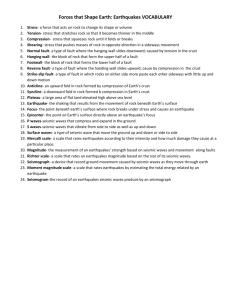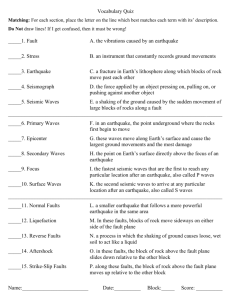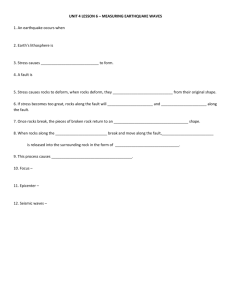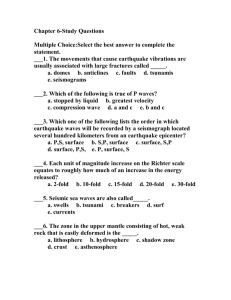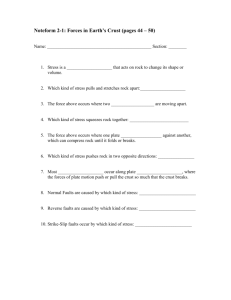Print › Earthquakes: Chapter 5 | Quizlet | Quizlet
advertisement
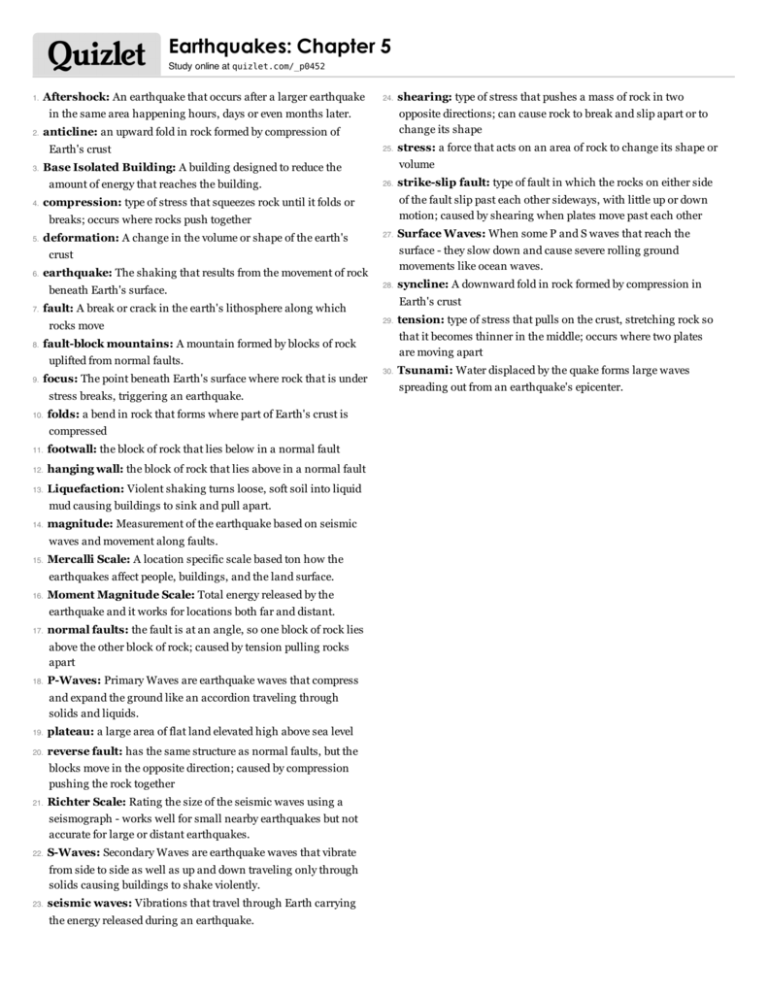
Earthquakes: Chapter 5 Study online at quizlet.com/_p0452 1. Aftershock: An earthquake that occurs after a larger earthquake 24. in the same area happening hours, days or even months later. 2. 3. 25. 26. deformation: A change in the volume or shape of the earth's 27. earthquake: The shaking that results from the movement of rock beneath Earth's surface. 7. 8. 28. 29. focus: The point beneath Earth's surface where rock that is under stress breaks, triggering an earthquake. 10. folds: a bend in rock that forms where part of Earth's crust is compressed 11. footwall: the block of rock that lies below in a normal fault 12. hanging wall: the block of rock that lies above in a normal fault 13. Liquefaction: Violent shaking turns loose, soft soil into liquid mud causing buildings to sink and pull apart. 14. magnitude: Measurement of the earthquake based on seismic waves and movement along faults. 15. Mercalli Scale: A location specific scale based ton how the earthquakes affect people, buildings, and the land surface. 16. Moment Magnitude Scale: Total energy released by the earthquake and it works for locations both far and distant. 17. normal faults: the fault is at an angle, so one block of rock lies above the other block of rock; caused by tension pulling rocks apart 18. P-Waves: Primary Waves are earthquake waves that compress and expand the ground like an accordion traveling through solids and liquids. 19. plateau: a large area of flat land elevated high above sea level 20. reverse fault: has the same structure as normal faults, but the blocks move in the opposite direction; caused by compression pushing the rock together 21. Richter Scale: Rating the size of the seismic waves using a seismograph - works well for small nearby earthquakes but not accurate for large or distant earthquakes. 22. S-Waves: Secondary Waves are earthquake waves that vibrate from side to side as well as up and down traveling only through solids causing buildings to shake violently. 23. seismic waves: Vibrations that travel through Earth carrying the energy released during an earthquake. tension: type of stress that pulls on the crust, stretching rock so that it becomes thinner in the middle; occurs where two plates are moving apart fault-block mountains: A mountain formed by blocks of rock uplifted from normal faults. 9. syncline: A downward fold in rock formed by compression in Earth's crust fault: A break or crack in the earth's lithosphere along which rocks move Surface Waves: When some P and S waves that reach the surface - they slow down and cause severe rolling ground movements like ocean waves. crust 6. strike-slip fault: type of fault in which the rocks on either side of the fault slip past each other sideways, with little up or down motion; caused by shearing when plates move past each other compression: type of stress that squeezes rock until it folds or breaks; occurs where rocks push together 5. stress: a force that acts on an area of rock to change its shape or volume Base Isolated Building: A building designed to reduce the amount of energy that reaches the building. 4. opposite directions; can cause rock to break and slip apart or to change its shape anticline: an upward fold in rock formed by compression of Earth's crust shearing: type of stress that pushes a mass of rock in two 30. Tsunami: Water displaced by the quake forms large waves spreading out from an earthquake's epicenter.


